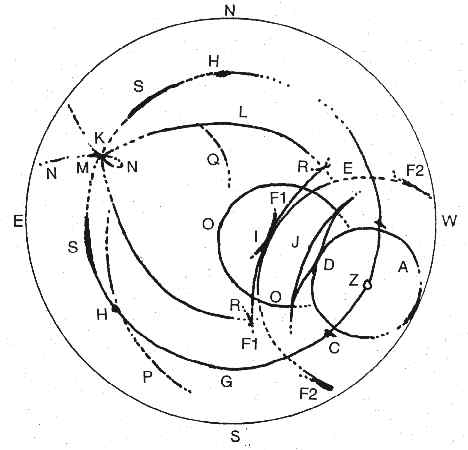|
4 Dec 2006 Jarmo Moilanen |
||||||||||||||||||||||||||||||||||||||||||||||||||||||||||||
A short introduction into halosCelestial Pattern of Arcs and Spots
Halo phenomena are white or coloured arcs and spots on day or night sky.
They are caused by tiny ice crystals that usually hower in thin cirrus
clouds. Halos can appear even 200 days a year - still, few people are
aware of them as usually they are faint and located near the glare of the
sun. A few times a year halos can occupy the whole of sky creating a
bright, symmetrical pattern.
Frequently Observed halos
The most common halo is the 22° halo that is caused by randomly oriented hexagonal ice
crystals. The dimension 22° refers to the constant radius of the ring - its angular distance
from the sun or moon is always the same, 22°. At least a piece of this ring should be able to
be seen a couple of times a week, in spring more often.
22° halo
22° tangent arcs / circumscribed halo
sun pillar
(22°) parhelia
46° halo
circumzenith arc & circumhorizon arc
(46°) supralateral arc & (46°) infralateral arc
subsun
parhelic circle
Rare Halos
There are dozens of separate halos documented in nature. The large
majority of these are very rare. They might appear only once or twice
during a century at any observing location. The displays that include
these halos, St. Andrew arcs for instance, are those that create an all-sky
dazzling web pattern and are seen also by laymen.
Parry arcs (upper sunvex and suncave, lower sunvex and suncave)
120° parhelia
Lowitz arcs (upper, lower and circular)
subparhelia
sub-parhelic circle
Wegener anthelic arcs
Greenler anthelic arcs (diffuse anthelic arcs or anthelion)
Tricker anthelic arcs
"reflected Lowitz arcs"
heliac arc
subhelic arc
Tape arcs (= 46° Parry supralateral and 46° Parry
infralateral arcs)
subanthelic arc
"sub-Lowitz arcs"
"120° parhelic Lowitz arcs"
"120° parhelic arcs" (not accepted as a separate
halo form by some researhers)
Liljequist parhelia
Hastings anthelic arcs
Liljequist subparhelia
46° contact arcs
A list of photographically documented "odd radius" halos - these arcs are
caused by pyramidal-shape ice crystals that have a pyramidal top angle
of 56.142°
9° halo (Van Buijsen halo)
18° halo (Rankin halo)
20° halo (Burney halo)
23° halo (Barkow halo)
24° halo (Dutheil halo)
35° halo (Feuillée halo)
9° upper & lower parhelia (or plate arcs)
18° parhelia
20° upper & lower parhelia (or plate arcs)
23° upper & lower parhelia (or plate arcs)
24° upper & lower parhelia (or plate arcs)
35° upper & lower parhelia (or plate arcs)
9° tangent (or column) arcs
18° upper tangent (or column) arcs
20° tangent (or column) arcs
24° upper tangent (or column) arcs
35° upper tangent (or column) arcs
pyramidal heliac arc
Documented halos maybe originated from cubic ice crystals.
"19° lateral arcs" *
"19° upper & lower arc" *
"28° halo" (or Scheiner's halo) *
"28° upper A & lower tangent arc" *
"28° infralateral/supralateral arcs" *
"28° parhelia B" *
Other documented halos. elliptical halos
Bottlinger rings
44° parhelia (parhelia of parhelia = double scattering halo)
Moilanen arc (unc) *
"6° halo" (unc) *
"12° halo" (unc) *
(unc) means that origination of the
halo is still unclear *) There is a possibility, that these
halos are made by a special kind of ice crystal. So they may form a group of
halos. Special halos or effects around divergent light source (artificical
light sourse like a street lamp)
superparhelia (parhelia with one extra reflection from upper
basal face) "subsun pillar" (subsun with one extra reflection
from upper basal face) "22° halo's intersection ring on ground" (an
effect) Special effects on halos blue spot on parhelic circle (when ray path 1-3-2 loses red
color to circumzenith arc) |
